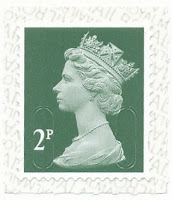Just as you may have thought that there wouldn't be much more of interest in Machins, along comes the Big 2nd. It's big because it is 38mm x 30mm including perforations. the 'stamp' part, excluding perforations is 22½mm x 28mm compared to 18mm x 22mm for the familiar size stamp area.
Separated by a rather bizarre printed 'perforation' line is a panel containing what I believe is now referred to as a 2D barcode. I still call these things, whether square or rectangular, QR codes and the app on my phone is a QR reader but, whatever you wish to call it, this is a big new addition.
Each of these panels contains a set of characters which will be unique for each label. The one illustrated above and below have these sets of characters:
JGBS1123101703 114139229 00066 231120 01 D7F8DD75094BEF1 501JGBS1123101703 123311783 00066 040121 01 140D0D76722095E 501
Messrs. B Alan Ltd have made some intelligent guesses as to the translation of some of these and you will be able to identify a date and a value fairly easily. One was printed on 23/11/2020 and the other 04/01/21, both having a denomination at the time of 66p.
There are other educated guesses they make regarding the position of the label on a sheet of labels but that's about as far as anyone can go.
This label I can envisage having several purposes as well as the obvious security function. It will prevent the label being used twice without penalty when scanned by new reading devices at sorting offices. I am sure this happens a lot at the moment with very few of my stamps ever being franked or marked. The security slits do make them difficult to take off an envelope but I have seen plenty of instances where the stamp and backing have just been cut out and stuck on another envelope. You may think this is an obvious ruse but how do we know that someone simply needed to use a different envelope and the transfer is entirely innocent? So that's one purpose.
Another could be to enable us to track items to which this label has been applied. I can see an app being launched in time to come which will let us see where our post may or may not be
Something no-one has mentioned so far that I have seen is the possible effect of including a denomination. For many years we have been able to hoard piles of NVI stamps and defer payment of new higher rates. When a particularly large increase is announced in advance then there is a great incentive to go and buy as many as you can as the stock will be worth considerably more a few weeks later. I am sure people have done this and even sold sheets at a price to businesses that still represents a discount on the new rate but gives the seller a worthwhile profit. This new code will, however, specify an amount - 66p in this case - and I can well imagine that this could determine the 'value' of the label when used in part-payment of postage and, more significantly, in future when 2nd Class postage may increase to, say, 70p and we'll be asked for another 4p, or whatever the difference happens to be at the time.
It is suggested that the Big size is not a permanent thing and that the stamp area may reduce to normal size, with a proportionately smaller label to the side, and that this concept may be spread across some other denominations.
I can imagine that there was much debate about whether to include the wavy line to imitate perforation and those promoting this won. Here's what a 1st Class might look like without it!
The second printing that I have of the 2nd Class issue has a slightly different shade and a much more reflective ink for the background. This does not show in these scanned images, however, but is most noticeble in daylight at an angle.
Both issues bear the normal code M21L MBIL.
The 10p light tan has a bright fluor. Still M20L MAIL code.
A noticeably brighter shade of bright blue for this 2nd Class issue, from business sheets.




























